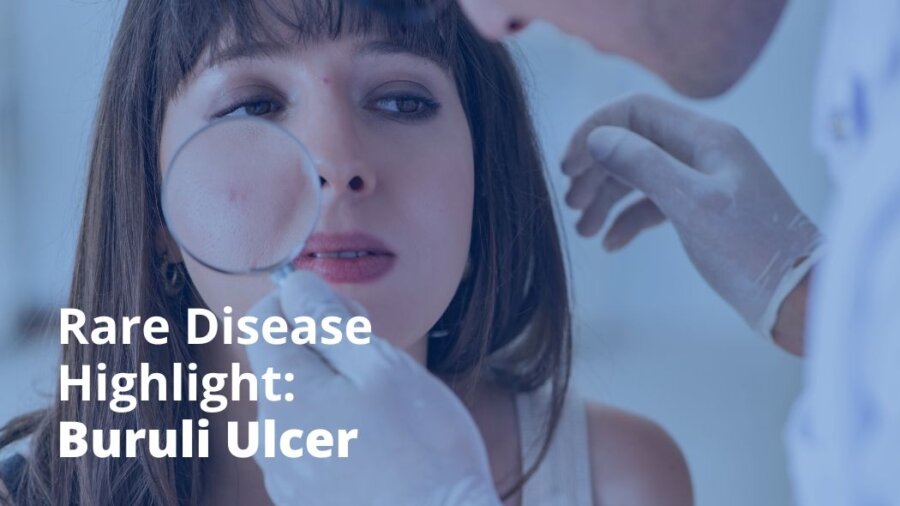Buruli ulcer (BU) is a chronic skin infection caused by Mycobacterium ulcerans (M. ulcerans) resulting in death of body tissue, also referred to as necrosis (Scherr et al., 2018). M. ulcerans is the third most common mycobacterial infection worldwide and is classified as a neglected tropical disease by the World Health Organization (WHO) (O’Brien et al., 2018). Cases ofBU have occurred in at least 33 countries, with the highest concentration of cases in Western Africa (Guarner, 2018). M. ulcerans cases are also found in Australia (Guarner, 2018; Thomas et al., 2014). BU is not endemic to the US, however, rare cases have occurred in travelers returning from endemic regions (Thomas et al., 2014). The exact mode of transmission of BU is unknown, and studies have investigated potential risk factors such as insect bites and injuries occurring near bodies of water contaminated with M. ulcerans. BU is not considered a contagious disease, as there are no known cases of human-to-human transmission (Guarner, 2018; Thomas et al., 2014).
M. ulcerans mycobacteria produce a toxin, mycolactone, which diffuses out of the mycobacteria and accumulates in important cells in the body, such as fibroblasts and macrophages (Guarner, 2018). Fibroblasts contribute to the formation of connective tissue that supports and connects other tissues or organs in the body, while macrophages are critical for immunity and tissue development and repair (NIH, 2022; Watanabe et al., 2019). Thus, mycolactone targets and binds to scaffolding and other proteins, disrupting cellular structure and function (Guarner, 2018). The downstream effects of the mycolactone toxin can lead to BU. BU starts as a lesion, which progresses to extensive skin ulceration. Early stages of the disease are significantly painful, but as the disease progresses, the lesional loss of tissue is painless or with limited pain. This is thought to be a result of mycolactone activating type 2 angiotensin II receptors (Yotsu et al., 2018). These receptors are associated with regulating pain, so activation decreases sensations to the skin (Pulakat et al., 2020; Yotsu et al., 2018). Patients left untreated have a risk of disease progression resulting in high morbidity, including physical deformities from skin loss and permanent disability as a result of the spread of necrotizing skin infection to bones and joints (O’Brien et al., 2018).
Effective therapeutic options for BU are limited in the US and worldwide. Patients diagnosed and treated in early stages of the disease have a good prognosis and treatment outcome. However, patients left untreated have a risk of disease progression resulting in high morbidity and permanent disability (O’Brien et al., 2018). Standard of care treatment for BU consists of a combination of antibiotics and complementary treatments. The combination of rifampicin (RIF, 10 mg/kg once daily) and clarithromycin (CLR, 7.5 mg/kg twice daily) is now the recommended treatment by the WHO (WHO, 2022). Despite the success of the RIF+CLR combination therapies, these regimens still require 2 months of treatment, often resulting in patient or provider nonadherence (Phillips et al., 2020). Considering the severe morbidity of the disease and the limited treatment options for patients with BU, novel therapies are necessary to address the unmet medical need for this patient population.
References
Guarner. (2018). Buruli Ulcer: Review of a Neglected Skin Mycobacterial Disease. Journal of Clinical Microbiology, 56(4), e01507-01517. doi:10.1128/jcm.01507-17
NIH. (2022). Fibroblast. Retrieved 07/11/2022 from https://www.genome.gov/genetics-glossary/Fibroblast#:~:text=A%20fibroblast%20is%20a%20type,the%20structural%20framework%20of%20tissues.
O’Brien, Jeanne, Blasdell, Avumegah, & Athan. (2018). The changing epidemiology worldwide of Mycobacterium ulcerans. Epidemiol Infect, 1-8. doi:10.1017/S0950268818002662
Phillips, Robert, Abass, Thompson, Sarfo, Wilson, Sarpong, Gateau, Chauty, Omollo, Ochieng Otieno, Egondi, Ampadu, Agossadou, Marion, Ganlonon, Wansbrough-Jones, Grosset, Macdonald, Treadwell, Saunderson, Paintsil, Lehman, Frimpong, Sarpong, Saizonou, Tiendrebeogo, Ohene, Stienstra, Asiedu, van der Werf, Osei Mireku, Abotsi, Adu Poku, Asamoah-Frimpong, Osei-Wusu, Sarpong, Konadu, Opoku, Forson, Ndogyele, Ofori, Aboagye, Berko, Amofa, Nsiah, Mensah-Bonsu, Ofori Nyarko, Amoako, Koranteng Tannor, Boakye-Appiah, Dzibordzi Loglo, Sarpong-Duah, Agbavor, Ardent, Yamadjako, Adanmado Gersande, Adeye, Kindjinou, Akpolan, Kiki, Sodjinou, Guegnard, Klis, Velding, Omansen, Ofori-Adjei, Eyangoh, Knell, & Faber. (2020). Rifampicin and clarithromycin (extended release) versus rifampicin and streptomycin for limited Buruli ulcer lesions: a randomised, open-label, non-inferiority phase 3 trial. The Lancet, 395(10232), 1259-1267. doi:10.1016/S0140-6736(20)30047-7
Pulakat, & Sumners. (2020). Angiotensin Type 2 Receptors: Painful, or Not? Front Pharmacol, 11, 571994. doi:10.3389/fphar.2020.571994
Scherr, Bieri, Thomas, Chauffour, Kalia, Schneide, Ruf, Lamelas, Manimekalai, Grüber, Ishii, Suzuki, Tanner, Moraski, Miller, Witschel, Jarlier, Pluschke, & Pethe. (2018). Targeting the Mycobacterium ulcerans cytochrome bc1:aa3 for the treatment of Buruli ulcer. Nature Communications, 9(1), 5370. doi:10.1038/s41467-018-07804-8
Thomas, Bailey, Bhatnagar, Ritter, Emery, Jassim, Hornstra, & George. (2014). Mycobacterium ulcerans infection imported from Australia to Missouri, USA, 2012. Emerg Infect Dis, 20(11), 1876-1879. doi:10.3201/eid2011.131534
Watanabe, Alexander, Misharin, & Budinger. (2019). The role of macrophages in the resolution of inflammation. J Clin Invest, 129(7), 2619-2628. doi:10.1172/jci124615
WHO. (2022). Buruli ulcer (Mycobacterium ulcerans infection). Retrieved 07/01/2022 from https://www.who.int/news-room/fact-sheets/detail/buruli-ulcer-(mycobacterium-ulcerans-infection).
Yotsu, Suzuki, Simmonds, Bedimo, Ablordey, Yeboah-Manu, Phillips, & Asiedu. (2018). Buruli Ulcer: a Review of the Current Knowledge. Curr Trop Med Rep, 5(4), 247-256. doi:10.1007/s40475-018-0166-2
BioPharma Global is a mission-driven corporation dedicated to using our FDA and EMA regulatory expertise and knowledge of various therapeutic areas to help drug developers advance treatments for the disease communities with a unmet medical needs. If you are a drug developer seeking regulatory support for Orphan Drug designation, Fast Track designation, Breakthrough Therapy designation, other FDA/EMA expedited programs, type A, B (pre-IND, EOPs), or C meeting assistance, or IND filings, the BioPharma Global team can help. Contact us today to arrange a 30-minute introductory call.

